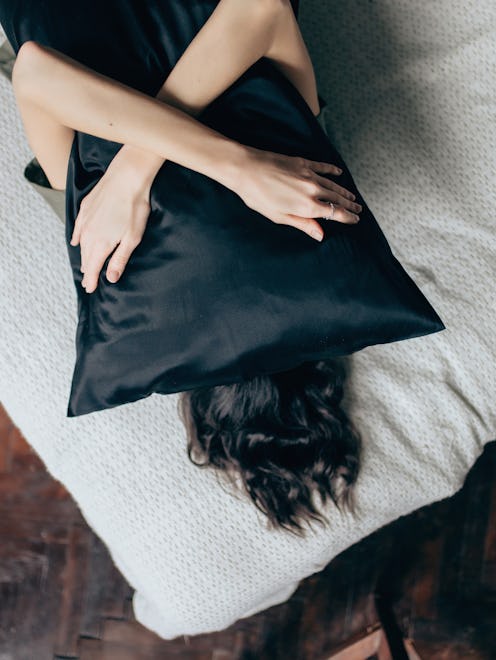(Beauty)
This Luxe Must-Have Is The Easiest Route To Healthier Hair And Skin
Literally all you have to do is sleep.

When it comes to the health of your skin and hair, beauty sleep is as necessary as those holy-grail potions and products you have hiding behind your bathroom mirror. And if you’ve been following along with sleep trends over the past few years, then there’s no doubt you’ve heard the beauty community raving about the benefits of silk pillowcases. But are these luxury bedding buys actually worth the hype?
I spoke with Dr. Loretta Ciraldo MD FAAD, a Miami-based board certified dermatologist with over 40 years' experience, to get the scoop. And, according to the expert, this silky slumber staple is one of the easiest ways to obtain healthier hair and skin.
What Are The Benefits Of Silk Pillowcases?
Why should you choose silk over something as ubiquitous (and, by all accounts, just as boujee) as, let’s say, Egyptian cotton? It’s pretty simple: Cotton can absorb some of the skin's moisture, whereas silk doesn't.
If you have a tendency towards dry skin, use potentially drying skin care like retinoids or AHAs, or use some form of climate control in your bedroom (such has a heater or dehumidifier), Dr. Ciraldo suggests replacing your cotton or poly-blend pillowcases with silk ones to keep your complexion better hydrated.
Silk fibers also regulate temperatures and are breathable, which will help you keep cool during the night. And since silk’s temperature-regulating properties mitigate night sweats, making the switch to silk may help with breakouts if pillowcase sweat and bacteria are the root cause. (Although it’s worth noting that sleeping on silk is not considered a treatment for acne, like adapting a clarifying topical regimen.)
Another benefit of a silk pillowcase is that the soft surface doesn’t crease as much as some standard cotton pillowcases do (especially lower thread count ones). These fabric wrinkles might leave you with short-lived creases on your surface skin, so-called "pillowcase wrinkles,” when you wake, explains Dr. Ciraldo. Slumbering on smooth silk, on the other hand, will have you waking to similarly smooth skin.
Wondering how silk pillowcases impact your locks? Well, just like how silk won’t steal moisture from skin, the same is true of strands. It also reduces the friction, so expect less frizz, sleeker strands and an absence of bedhead, too.
Is Silk Naturally Hypoallergenic?
There’s some debate about this one. While some experts and diehards claim silk is naturally hypoallergenic, others, like Dr. Ciraldo, feel that’s not really the case. “The true culprit here are the dust mites that collect on our pillowcases — regardless of the fabric — and carry allergens. This happens whether you are sleeping on silk or cotton. Best practice is to wash your pillowcases every three days,” says Dr. Ciraldo.
How Long Before You’ll Notice The Benefits Of Silk Pillowcases?
The very first morning you wake up from snoozing on a silk pillowcase, your face should be free from those “pillowcase wrinkles” and your hair smoother and with fewer tangles. Dr. Ciraldo adds that you should see a more hydrated complexion in about a week.
Is A Silk Pillowcase Worth The Money?
Silk doesn’t come cheap, but it should be seen as an investment towards a more blissful, beautifying slumber. Don’t be fooled by inexpensive dupes: Spend your money on the real deal —mulberry silk with a weight of 22 momme or higher. (For silk novices, momme is the unit of measurement used to determine a silk's weight and quality.) And always follow the care instructions to ensure your silk pillowcases last.
Does Satin Offer The Same Benefits?
Sort of. Silk is a natural material that’s produced by silkworms. Meanwhile, satin is technically a type of weaving that’s commonly made from silk and a blend of synthetic fibers, such as polyester and rayon. Satin also delivers a sumptuous feel and has a smoother slip than cotton, minimizing friction on skin and hair. Plus, it comes at a significantly lower price point, so it’s a great option if you’re on a budget.
Silk Pillowcase Review
To preface, I’m a diehard silk pillowcase enthusiast, so my review is an accumulation of positives I’ve experienced over the past five years. Not only has making the switch left my skin feeling more hydrated — even during the harsh winter months — but I don’t wake up with those awful creases on my face. I also notice fewer flyaways and my blowouts last longer.
Sleeping on silk is also just so much more comfortable, too. To that end, I was recently traveling and got my silk pillowcase dirty. I figured it’s just one night, I’ll sleep on the pillowcase provided by the hotel. Big mistake. I was tossing and turning all night. The cotton felt crunchy against my skin, and it wasn’t cool and refreshing like silk. So from now on, I’ll always pack a backup, because a blissful and beauty-boosting night's sleep is not something I’m willing to leave up to chance.
To get a similarly restful and aesthetically rejuvenating slumber, I recommend Belledorm’s 100 percent mulberry silk pillowcases. Available in three soft hues, they’ll have you sleeping your way to healthier hair and skin thanks to their 450-thread count natural silk fabric.
For a less expensive option, look to Luxurious Wellniss’s satin pillowcase set. It’ll give you similar skin-and hair-smoothing results, and the set comes with two pillowcases.
This article was originally published on